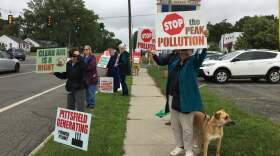The Pittsfield, Massachusetts board of health heard a report on radiofrequency emissions from a controversial cell tower at its meeting Wednesday night.
The Verizon tower at 877 South Street has been the source of local outrage for months, with community members attributing a bevy of health concerns to exposure to emissions from the site.
“RF emission survey is a typical survey that we do for cell sites," said Stephanie Koles, a representative of V-COMM, a New Jersey-based telecommunications consulting firm. “We certainly have a tower here that has multiple bands in use. You have a cell tower which has spectrum in 700 and in 850 and in 1900 and 2100 megahertz. Those are the standard cellular bands that everybody uses on their cell phone. There are certainly others that are now being licensed for use for expanding capacity.”
She told the board of health that V-COMM picked a number of points throughout the neighborhood adjacent to the tower to measure RF emissions based on FCC standards for exposure limits.
“Between 30 megahertz and 300 megahertz range, your body tends to absorb more energy," explained Koles. "Because of the wavelength. It's longer at that frequency, and it's about six feet, somewhere in that range in that frequency spectrum. So, 300 kilohertz is a very long wavelength. I mean, your body's not, like, miles long. You're six feet, technically. And as you go up in frequency, the wavelength changes, and it gets shorter and shorter and shorter. So it has less impact on you, your form.”
V-COMM’s tests were conducted during morning rush hour, when cell tower usage is at a maximum.
“The total measurement, the 1.66%, is a very small amount of the overall of the limit," said Koles. "1.66% of the total limit shown on that chart in terms of milliwatts per centimeter squared.”
That’s well below FCC limits for RF emissions.
Koles said topography played a role in the findings, noting the tower’s hilltop location.
“The tower itself, and the antennas mounted on the very top of the tower are very directional," she said. "Most of the energy is transmitted out in each direction from each group of antennas. And significantly less portion of the signal ends up going down to the ground level. That's why these readings are so low.”
That isn’t the only natural variable in the emissions testing.
“Foliage does have an effect," said Koles. "Every year, you know, we see as a carrier, they see changes in traffic levels and performance of sites because of the foliage. So it does actually affect levels.”
Koles was asked if there would be a significant difference in RF levels if there was a change in the direction of the tower’s antennas based on different elevations in the area.
“The only changes made ongoing could be the antenna downtilts, changing the footprint of the actual signal further out into a certain area where it's looking, where the antennas are looking or serving," she answered. "But if the antennas are actually changed for some reason, which is highly unlikely, there may be some changes on the ground.”
The board of health says it will continue its efforts to address community concerns with the cell tower.







